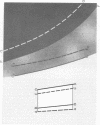Abstract
Bell, C. R., and Watts, A. J. (1971).Brit. J. industr. Med.,28, 259-264. Thermal limits for industrial workers. The literature on relationships between man's comfort, efficiency, and physical well-being and the nature of his thermal working environment is diverse and highly specific. Industrial practice requires more general `concensus' data on which to base reasonable recommendations for the establishment of thermal environmental limits. A series of three such limits is proposed which provide protection of the workers' comfort, efficiency, and physiological safety.
For sedentary workers it is suggested that in summer an upper limit of 21·8°C C.E.T. is advisable if not less than 80% of workers are to be free from discomfort. Against a similar criterion in winter a lower limit of 15·5°C C.E.T. is proposed. An extrapolation of data from laboratory to industrial work-places provides a suggested limit for efficiency at skilled tasks at 26·7°C C.E.T. Finally, a limit of environmental severity based upon an absence of severe physiological distress in 95% of exposed workers is proposed which varies with the age and physical fitness of the workers and the physical demands of the work they are called upon to perform.
Full text
PDF





Images in this article
Selected References
These references are in PubMed. This may not be the complete list of references from this article.
- BELL C. R., PROVINS K. A. Effects of high temperature environmental conditions on human performance. J Occup Med. 1962 Apr;4:202–211. [PubMed] [Google Scholar]
- Bell C. R., Walters J. D. Reactions of men working in hot and humid conditions. J Appl Physiol. 1969 Nov;27(5):684–686. doi: 10.1152/jappl.1969.27.5.684. [DOI] [PubMed] [Google Scholar]
- HICKISH D. E. Thermal sensations of workers in light industry in summer; a field study in southern England. J Hyg (Lond) 1955 Mar;53(1):112–123. doi: 10.1017/s0022172400000565. [DOI] [PMC free article] [PubMed] [Google Scholar]
- TEICHNER W. H., WEHRKAMP R. F. Visual-motor performance as a function of short-duration ambient temperature. J Exp Psychol. 1954 Jun;47(6):447–450. doi: 10.1037/h0060272. [DOI] [PubMed] [Google Scholar]



